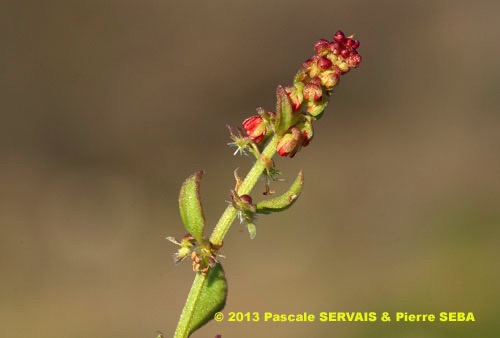
Rumex bucephalophorus L.
Fam. : Polygonaceae
© Pascale SERVAIS & Pierre SEBA, 2018. Tilo Botanica: Flore de Tilos et du Dodécanèse / Flora of Tilos and of the Dodecanese
English translation by Brenda Bradbury, Howard Bradbury and Stéphane Léonard
Plante herbacée, hermaphrodite, souvent rougeâtre, glabre, à plusieurs tiges dressées, se ramifiant dès la base.
Feuilles alternes, simples, entières, de 10 à 20 mm de long, les inférieures spatulées, les supérieures lancéolées, poilues. Stipules soudées en tube membraneux entourant la tige (ochréa), à 2 lobes blanc luisant, aigus et dressés.
Fleurs à symétrie radiaire, vert rougeâtre, pédonculées, réunies par 2 ou 3 en grappes allongées. Seules les fleurs inférieures portent une bractée à leur base. Périanthe à 6 tépales. Ovaire supère.
Fruits, petits akènes à dents arquées, portés par des pédoncules courbés.
___________________________
Plant herbaceous, hermaphrodite, often reddish, glabrous. Stems several, erect, branched from the base.
Leaves alternate, simple, entire, from 10 to 20 mm long, the lower ones spatulate, the higher ones lanceolate, hairy. Stipules fused in a membranous tube surrounding the stem (ochrea), with 2 shiny white, acute and erect lobes.
Flowers radially symmetrical, reddish green, stalked, joined together by 2 or 3 in lengthened racemes. Only the lower flowers carry a bract at their base. Perianth with 6 tepals. Ovary superior.
Fruits, small achenes with curved teeth, carried by curved peduncles.
Descripteurs / Identifying features
1
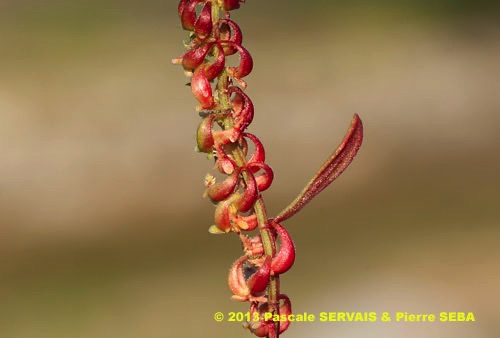
2
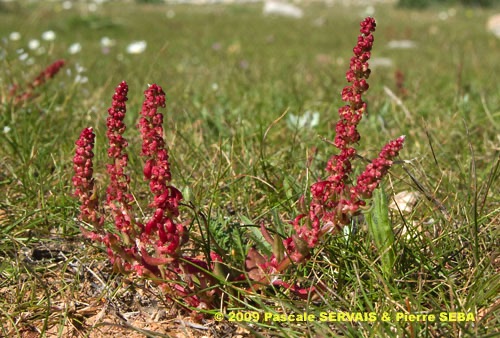
3
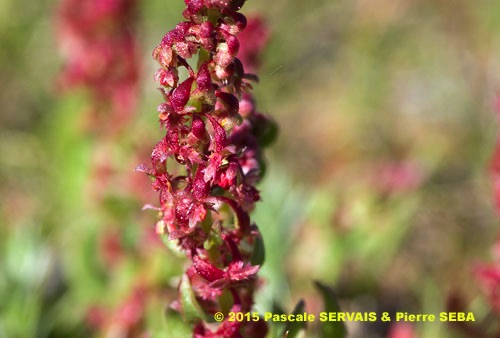
4
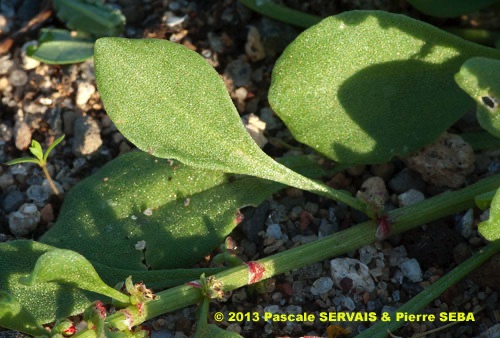
5
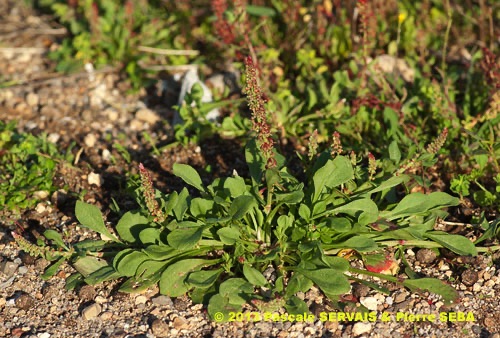
6
Étymologie / Etymology :
Rumex : emprunt du latin rumex, -icis (nom) = le dard, l’oseille, nom
donné à la plante par Pline, naturaliste latin mort en 79 apr. J.-C.,
en référence à la forme pointue des feuilles de beaucoup d'espèces
de ce genre.
Bucephalophorus : adjectif créé par les botanistes [ < βοῦς, βοός (nom)
= le bœuf, la vache + κεφαλή, -ῆς (nom) = la tête + φέρω (verbe)
= porter ] = qui porte une tête de bœuf, en référence aux fruits dont
les valves cornues suggèrent une tête de bœuf.
Rumex : borrowed from Latin rumex, -icis (noun) = sting, sorrel, name
given to the plant by Plinius, Latin naturalist died in 79 AD, referring to
the pointed shape of the leaves of many species of this genus.
Bucephalophorus : adjective created by botanists
[ < βοῦς, βοός (noun) = ox, cow + κεφαλή, -ῆς (noun) = head
+ φέρω (verb) = to carry ] = which carries an ox head, referring to
the fruits whose horned valves suggest an ox head.
Synonymes / Synonyms :
Bucephalophora aculeata Pau
Bucephalophora aculeata subsp. hispanica (Steinh.) Á.Löve & B.M.Kapoor
Rumex bucephalophorus var. hispanicus Steinh.
Noms vernaculaires / Common names :
Noms français / French names :
Oseille tête-de-bœuf — Rumex tête-de-bœuf.
Nom grec / Greek name :
Ξινολάπαθο.
Noms anglais / English names :
Horned dock — Red dock — Ruby dock.
Noms allemands / German names :
Ochsenkopf-Ampfer — Ochsenköpfiger Ampfer — Stierkopf-Ampfer.
Noms espagnols / Spanish names :
Acedera borde — Acedera de lagarto.
Nom italien / Italian name :
Rómice Capo di bue.
Habitat :
Cultures - Jardins - Lieux pierreux - Lieux humides, mares -
Sols sableux.
Cultivated places - Gardens - Stony places - Damp places, ponds -
Sandy soils.
Île / Island :
Tilos.
Hauteur / Height range :
De 5 cm à 30 cm.
From 5 cm to 30 cm.
Floraison / Flowering time :
De janvier à septembre.
From January to September.
Groupe / Classification :
Dicotylédones.
Dicotyledons.
Pérennité / Lifespan :
Annuelle.
Annual.
Description :
Clés dichotomiques et descripteurs distinctifs des 2 espèces / Dichotomous keys and distinctive identifying features of the 2 species
Photo 1 :
Localisation / Location : Tilos, Megalochorio, Plaine d’Erystos
Date : 13/01/2013
GPS : Lat. 36,43620° N / Long. 27,34945° E / Alt. 10 m
Type : Photographie numérique / Digital Photograph (10 mégapixels)
Photo 2 :
Localisation / Location : Tilos, Megalochorio, Plaine d’Erystos
Date : 14/01/2013
GPS : Lat. 36,43620° N / Long. 27,34945° E / Alt. 10 m
Type : Photographie numérique / Digital Photograph (10 mégapixels)
Photo 3 :
Localisation / Location : Tilos, Livadia, Environs
Date : 21/03/2009
GPS : Lat. 36,42228° N / Long. 27,38092° E / Alt. 135 m
Type : Photographie numérique / Digital Photograph (10 mégapixels)
Photo 4 :
Localisation / Location : Tilos, Livadia, Environs
Date : 21/03/2009
GPS : Lat. 36,42228° N / Long. 27,38092° E / Alt. 135 m
Type : Photographie numérique / Digital Photograph (10 mégapixels)
Photo 5 :
Localisation / Location : Tilos, Megalochorio, Plaine d’Erystos
Date : 13/01/2013
GPS : Lat. 36,43620° N / Long. 27,34945° E / Alt. 10 m
Type : Photographie numérique / Digital Photograph (10 mégapixels)
Photo 6 :
Localisation / Location : Tilos, Megalochorio, Plaine d’Erystos
Date : 13/01/2013
GPS : Lat. 36,43620° N / Long. 27,34945° E / Alt. 10 m
Type : Photographie numérique / Digital Photograph (10 mégapixels)

Google Maps
Google Maps
Google Maps
Google Maps
Google Maps
Google Maps